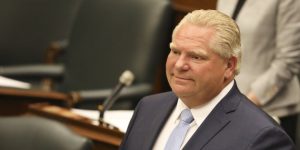
Ontario’s new Conservative Premier Doug Ford is attempting to shrink the Toronto City Council almost in half (from 47 to 25 members). The main argument is that the ever expanding size of the council does nothing to actually improve representation and effectiveness. Rather, it just leads to increased staff and costs for taxpayers.
Faith Goldy, currently running for Mayor of Toronto in October 22 election posted a YouTube video seen HERE, commenting on it. An amusing video.
On July 30, 2018, Bill 5, the “Better Local Government Act” got its first reading. August 14 saw it receive 2nd and 3rd readings and be passed. However, the Toronto City Council voted to proceed with a legal challenge against it in court.
The Council claimed that the bill violated the Canadian Charter of Rights and Freedoms. See HERE for a link to the text of the Charter.
On September 10, an Ontario Superior Court Judge ruled that the Provincial Government’s decision violated Section 2(b) of the Charter, which states: 2. Everyone has the following fundamental freedoms: …… (b) freedom of thought, belief, opinion and expression, including freedom of the press and other media of communication;”. Specifically, the Judge ruled that the Bill violated Torontonians’ right to “freedom of expression”.
To put it in more detail, because of the ongoing Mayoral and Council elections, cutting the Council size, it substantially interfered with municipal voters’ freedom of expression and the “right to cast a vote that can result in effective representation”.
However, the Ontario Government has decided to re-introduce the Bill, and instead rely on a different part of the Canadian Charter, Section 33, which is the “Notwithstanding Clause”. In short, this provision allows a Provincial or Federal Government to pass laws even though a Court considers them unconstitutional. 33(1) reads as follows:
“33. (1) Parliament or the legislature of a province may expressly declare in an Act of Parliament or of the legislature, as the case may be, that the Act or a provision thereof shall operate notwithstanding a provision included in section 2 or sections 7 to 15 of this Charter.”
To be fair, Section 33(3) of the Charter states that legislation passed this way will cease to have effect after 5 years.
The “Notwithstanding Clause” has been a part of the Charter since its inception, but has very rarely been used.
Application of Charter
32. (1) This Charter applies(a) to the Parliament and government of Canada in respect of all matters within the authority of Parliament including all matters relating to the Yukon Territory and Northwest Territories; and
(b) to the legislature and government of each province in respect of all matters within the authority of the legislature of each province.
There is an interesting twist to this story: The Charter effects both the Federal Government, and the Provinces and Territories. (See above for Section 32). However, Canada is also governed by the Principle of Paramouncy. In short, in the cases of competing laws, the highest power will succeed. Put plainly, Federal law tops Provincial law, and Provincial law tops Municipal law. There is a good deal of logic to this, as Federal law would mean nothing if cities and Provinces could simply legislate their way aroung it.
An exception to this of course: is that the various levels of power cannot legislate if doing so steps outside their legal boundaries. Sections 91 and 92 of the Constitution spell out exactly whose powers are whose.
Hypothetically, the Federal Government could invoke “their” Notwithstanding Clause in order to override “Ontario’s” Notwithstanding Clause. But that doesn’t seem to be happening, at least for now.
A very interesting use of the Notwithstanding Clause. Shows at least the Ontario Government is serious about cutting the size of government. We shall keep an eye on it.
AN UPDATE TO THE STORY: On, September 19, 2018, the Ontario Court of Appeals stayed the order of the Ontario Superior Court, effectively giving Premier Ford the go ahead to shrink Toronto City Council. An interesting note here — while the Court of Appeals did say that shrinking the Council in the middle of a municipal election was unfair, unfairness by itself is not a reason to stop Bill 5.
